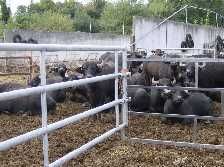Turning Buffalo Dung into Fertilizer and Energy
I’m going to be helping my new-found friend, Robert Orr of Manchester, England in his quest to build a facility to turn buffalo dung in Southern Pakistan into fertilizer and energy. How much dung are we talking about? It’s hard to imagine. First, try to picture 400,000 dairy buffaloes in an area of a few square miles – several hundred per acre. Now, figure that, between solids and liquids, you’re getting 25 pounds per day per head, or about 8,000 tons per day.
Then realize what’s happening to it currently:
• Some of the solids are separated and dried, then burned to make room for more. Of course, incinerating feces projects toxins into the air, causing ridiculous rates of disease, infant mortality, etc.
• Most of it forms a river and flows south into the Arabian Sea, a body of water that is now so polluted that fishermen row their boats through five miles of sewage every morning before they encounter anything still alive.
Robert has a refined and gentlemanly demeanor, yet carries with him a raw passion for the project, as well as perhaps a thinly disguised level of disgust and contempt that mankind has been brought to this horrific place. It will be a pleasure and an honor to work with him.
Here’s a report from the BBC on the program.


For many years, in India a few people have been using dung to make methane to use in stoves for cooking and for other purposes. It works, and if they start doing that in Pakistan, it could solve what appears to be a very serious pollution problem in addition to providing energy. It could be a good project. Probably you can find considerable information on how to use dung to make CH4; it’s not a new process.
If there is enough CH4 produced, it could even be used to run engines to generate electricity.
Hi Frank.
We’ll be using anaerobic digestion to produce biogas from the dung, its a very old established technology, and just having a single feed stock makes life much easier. Though the energy will be great (could generate 200,000MWh pa electricity) we will probably produce CNG as its one of the most popular transport fuels there. The most life changing aspects will come from removal of the manure as a pollutant and its use for compost and fertilizer as well as energy.
Turning the bio gas into CNG would be a reasonable thing to do if too much is produced to be used locally, i.e., within a few miles. Otherwise, it could be piped around the area to be used for cooking, heating water, etc.
In earlier times, manufactured gas was stored at low pressure in large tanks which used water seals. A portion of the tank was a huge cylinder that rose and fell as gas was added and removed. There was a frame with rollers to guide the cylinder. That kind of tank is a very old technology, but it might be useful to even out the flow of bio gas.
Here is a link to an article about that kind of gas tank:
http://en.wikipedia.org/wiki/Gas_holder
I don’t know whether any still exist.
Somewhere buried in my harddrive is some information about methane generators. What I remember off hand is that PH and temperature are key. Be ready to add or dissipate heat as required. Gotta keep the bacteria happy. I also thought the collector I was going to use for my hydrogen generator would work good for a methane generator also. The guy who came up with this information passed away some years ago but his ideas and data live on. Let me know if you want it.
Since you mention England and cattle at the same time I offer this article my stepdaughter posted on facebook yesterday.
http://topdocumentaryfilms.com/farm-for-the-future/
Great to know of the work of Robert,thanks to Stephen Last.
we have developed 2 projects in Bangladesh based on Chicken litter.Next we are working on a Biogas >CNG project from Maize wastes.
However congratulating Robert for his work & Brian’s daughter on her fine work!
At age 69 I have retired from business and decided to start a small – 10,000 kg per annum – organic fertilizer manufacturing unit using Chinese machinery. Set up on about 2 acres of land, the electricity needs will be met through bio bas generators, solar panels and of course wind turbines. This unit will be based in the immediate vicinity of Karachi city. Could someone help me put a feasibility together and per haps also see the project through on turn key basis. Naturally, I would finance this venture. contact me on intaspower@gmail.com
can we use this dung directly as a fertilizer for improving crops growth??